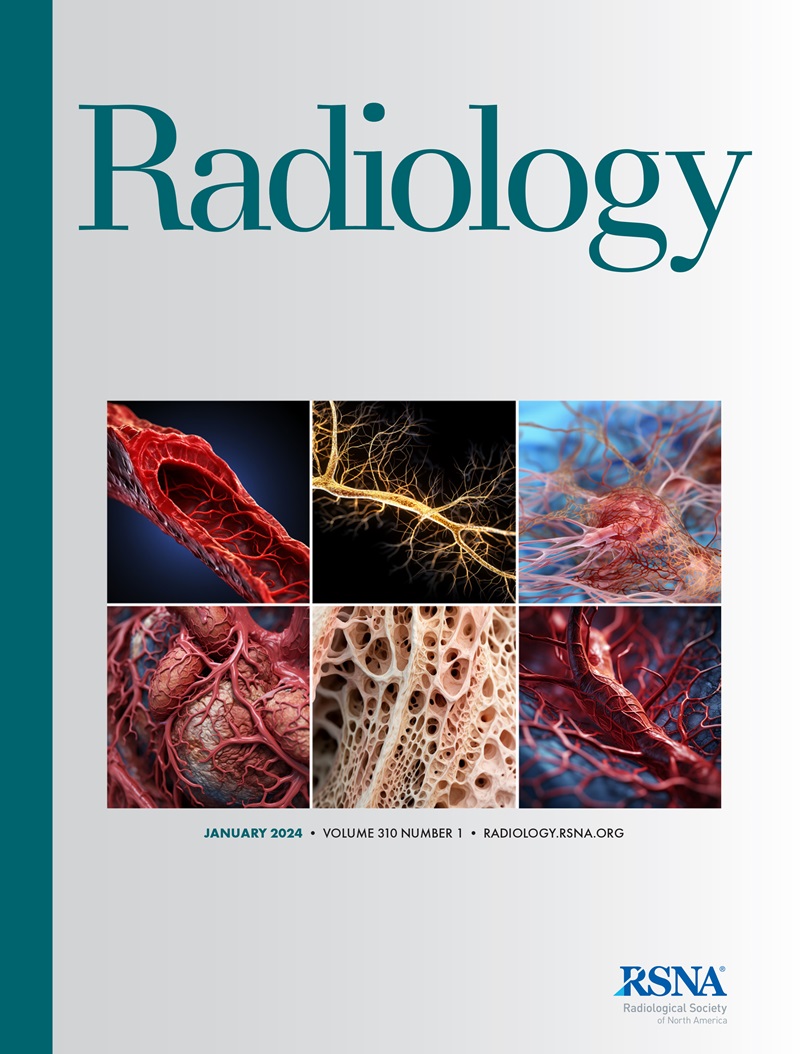Deep Learning Applications in Imaging of Acute Ischemic Stroke: A Systematic Review and Narrative Summary.
IF 12.1
1区 医学
Q1 RADIOLOGY, NUCLEAR MEDICINE & MEDICAL IMAGING
Bin Jiang, Nancy Pham, Eric K van Staalduinen, Yongkai Liu, Sanaz Nazari-Farsani, Amirhossein Sanaat, Henk van Voorst, Ates Fettahoglu, Donghoon Kim, Jiahong Ouyang, Ashwin Kumar, Aditya Srivatsan, Ramy Hussein, Maarten G Lansberg, Fernando Boada, Greg Zaharchuk
求助PDF
{"title":"Deep Learning Applications in Imaging of Acute Ischemic Stroke: A Systematic Review and Narrative Summary.","authors":"Bin Jiang, Nancy Pham, Eric K van Staalduinen, Yongkai Liu, Sanaz Nazari-Farsani, Amirhossein Sanaat, Henk van Voorst, Ates Fettahoglu, Donghoon Kim, Jiahong Ouyang, Ashwin Kumar, Aditya Srivatsan, Ramy Hussein, Maarten G Lansberg, Fernando Boada, Greg Zaharchuk","doi":"10.1148/radiol.240775","DOIUrl":null,"url":null,"abstract":"<p><p>Background Acute ischemic stroke (AIS) is a major cause of morbidity and mortality, requiring swift and precise clinical decisions based on neuroimaging. Recent advances in deep learning-based computer vision and language artificial intelligence (AI) models have demonstrated transformative performance for several stroke-related applications. Purpose To evaluate deep learning applications for imaging in AIS in adult patients, providing a comprehensive overview of the current state of the technology and identifying opportunities for advancement. Materials and Methods A systematic literature review was conducted following Preferred Reporting Items for Systematic Reviews and Meta-Analyses guidelines. A comprehensive search of four databases from January 2016 to January 2024 was performed, targeting deep learning applications for imaging of AIS, including automated detection of large vessel occlusion and measurement of Alberta Stroke Program Early CT Score. Articles were selected based on predefined inclusion and exclusion criteria, focusing on convolutional neural networks and transformers. The top-represented areas were addressed, and the relevant information was extracted and summarized. Results Of 380 studies included, 171 (45.0%) focused on stroke lesion segmentation, 129 (33.9%) on classification and triage, 31 (8.2%) on outcome prediction, 15 (3.9%) on generative AI and large language models, and 11 (2.9%) on rapid or low-dose imaging specific to stroke applications. Detailed data extraction was performed for 68 studies. Public AIS datasets are also highlighted, for researchers developing AI models for stroke imaging. Conclusion Deep learning applications have permeated AIS imaging, particularly for stroke lesion segmentation. However, challenges remain, including the need for standardized protocols and test sets, larger public datasets, and performance validation in real-world settings. © RSNA, 2025 <i>Supplemental material is available for this article.</i></p>","PeriodicalId":20896,"journal":{"name":"Radiology","volume":"315 1","pages":"e240775"},"PeriodicalIF":12.1000,"publicationDate":"2025-04-01","publicationTypes":"Journal Article","fieldsOfStudy":null,"isOpenAccess":false,"openAccessPdf":"","citationCount":"0","resultStr":null,"platform":"Semanticscholar","paperid":null,"PeriodicalName":"Radiology","FirstCategoryId":"3","ListUrlMain":"https://doi.org/10.1148/radiol.240775","RegionNum":1,"RegionCategory":"医学","ArticlePicture":[],"TitleCN":null,"AbstractTextCN":null,"PMCID":null,"EPubDate":"","PubModel":"","JCR":"Q1","JCRName":"RADIOLOGY, NUCLEAR MEDICINE & MEDICAL IMAGING","Score":null,"Total":0}
引用次数: 0
引用
批量引用
Abstract
Background Acute ischemic stroke (AIS) is a major cause of morbidity and mortality, requiring swift and precise clinical decisions based on neuroimaging. Recent advances in deep learning-based computer vision and language artificial intelligence (AI) models have demonstrated transformative performance for several stroke-related applications. Purpose To evaluate deep learning applications for imaging in AIS in adult patients, providing a comprehensive overview of the current state of the technology and identifying opportunities for advancement. Materials and Methods A systematic literature review was conducted following Preferred Reporting Items for Systematic Reviews and Meta-Analyses guidelines. A comprehensive search of four databases from January 2016 to January 2024 was performed, targeting deep learning applications for imaging of AIS, including automated detection of large vessel occlusion and measurement of Alberta Stroke Program Early CT Score. Articles were selected based on predefined inclusion and exclusion criteria, focusing on convolutional neural networks and transformers. The top-represented areas were addressed, and the relevant information was extracted and summarized. Results Of 380 studies included, 171 (45.0%) focused on stroke lesion segmentation, 129 (33.9%) on classification and triage, 31 (8.2%) on outcome prediction, 15 (3.9%) on generative AI and large language models, and 11 (2.9%) on rapid or low-dose imaging specific to stroke applications. Detailed data extraction was performed for 68 studies. Public AIS datasets are also highlighted, for researchers developing AI models for stroke imaging. Conclusion Deep learning applications have permeated AIS imaging, particularly for stroke lesion segmentation. However, challenges remain, including the need for standardized protocols and test sets, larger public datasets, and performance validation in real-world settings. © RSNA, 2025 Supplemental material is available for this article.
深度学习在急性缺血性脑卒中成像中的应用:系统回顾和叙述性总结。
急性缺血性脑卒中(AIS)是发病和死亡的主要原因,需要基于神经影像学快速准确的临床决策。基于深度学习的计算机视觉和语言人工智能(AI)模型的最新进展已经在几种与中风相关的应用中展示了变革性的性能。目的评估深度学习在成年AIS患者成像中的应用,全面概述该技术的现状,并确定其发展机会。材料和方法按照系统评价和荟萃分析指南的首选报告项目进行系统文献综述。从2016年1月到2024年1月,我们对四个数据库进行了全面的检索,目标是深度学习在AIS成像中的应用,包括大血管闭塞的自动检测和阿尔伯塔卒中计划早期CT评分的测量。文章是根据预定义的包含和排除标准选择的,重点是卷积神经网络和变压器。讨论了代表性最高的领域,并提取和总结了相关信息。结果纳入的380项研究中,171项(45.0%)关注脑卒中病变分割,129项(33.9%)关注分类和分流,31项(8.2%)关注结果预测,15项(3.9%)关注生成式人工智能和大型语言模型,11项(2.9%)关注脑卒中应用的快速或低剂量成像。对68项研究进行了详细的数据提取。公共AIS数据集也被强调,为研究人员开发中风成像的人工智能模型。结论深度学习应用已渗透到AIS成像中,特别是在脑卒中病灶分割方面。然而,挑战依然存在,包括对标准化协议和测试集的需求,更大的公共数据集,以及在现实环境中的性能验证。©RSNA, 2025本文可获得补充材料。
本文章由计算机程序翻译,如有差异,请以英文原文为准。

 求助内容:
求助内容: 应助结果提醒方式:
应助结果提醒方式:


